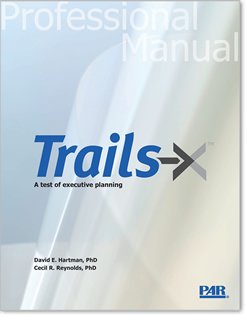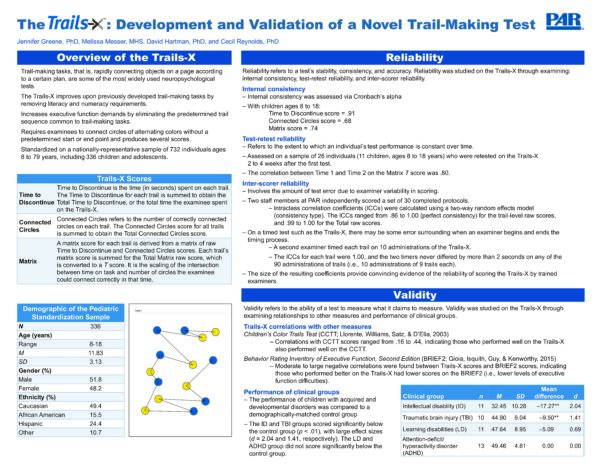
Trails-X [TRAILS-X]
Assesses adaptive planning and executive function through an innovative trail-making task
For Age: 8 – 79 years
Administration Time: 5-10 minutes
Administration Form: Paper and Pencil, Hand-scored
Authors: David E. Hartman, PhD, and Cecil R. Reynolds, PhD
Printed Kits
Click to browse products
Printed Manuals
Physical printed manuals.
Printed Forms & Handscoring Materials
Test forms, response booklets and scoring reference manuals.
Online Forms, Reports, Kits & e-Manuals
All online resources including Forms, Reports, i-Admins, Kits and e-Manuals.
Trails-X Introductory Kit
Trails-X Professional Manual
Trails-X Record Forms (pkg/25)
Trails-X Response Forms (pkg/25)
Trails-X e-Manual (includes Fast Guide e-Manual)
The Trails-X is an innovative take on the traditional trail-making task that includes additional executive function demands by requiring examinees to connect circles of alternating colors with no designated start or end point.
Individually administered, the Trails-X offers nine trails that assess adaptive planning, coupled with psychomotor speed, cognitive flexibility, impulse control, flexible attention, and the ability to adapt to novel or changing situations. The examinee is asked to draw straight, nonoverlapping lines connecting circles of alternating colors and continue until all circles are connected. Individuals must work carefully to avoid crossing lines or being forced to discontinue before the task is complete. Examinees must plan their path and adapt while working as quickly as possible.
Features and benefits
- Removes the requirement of numeracy and literacy as there is no need to be able to recognize letters or numbers, which makes this task language free and more culturally fair.
- Circles are yellow and blue, as they are colors that are least likely to be problematic for individuals who are colorblind.
Test structure
- Trails are scored by the number of correctly connected circles and the time spent on each trail, providing valuable insight into executive planning capacity, strategy, and variability. Taken together, these scores create a Total Matrix score, which describes consistency of performance.
- Percentile ranks, cumulative percentages, reliable change, and optional scores are also available.
Technical information
- Standardized on a sample of 732 individuals drawn from a population-proportionate sampling plan based upon U.S. Census data.
- The alpha coefficient for the standardization sample was .76 and .85 for the combined clinical sample.
 NZ
NZ






